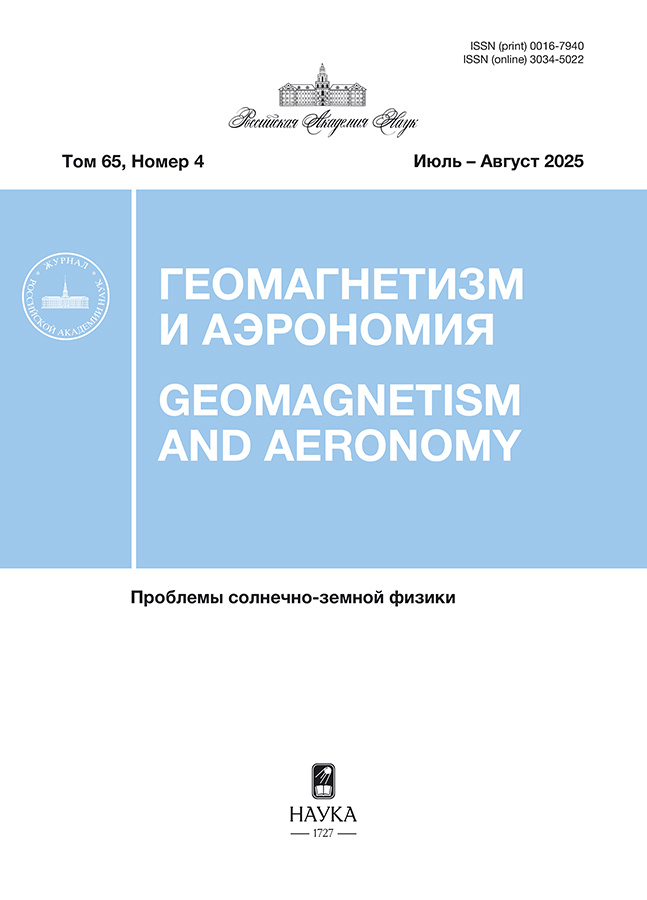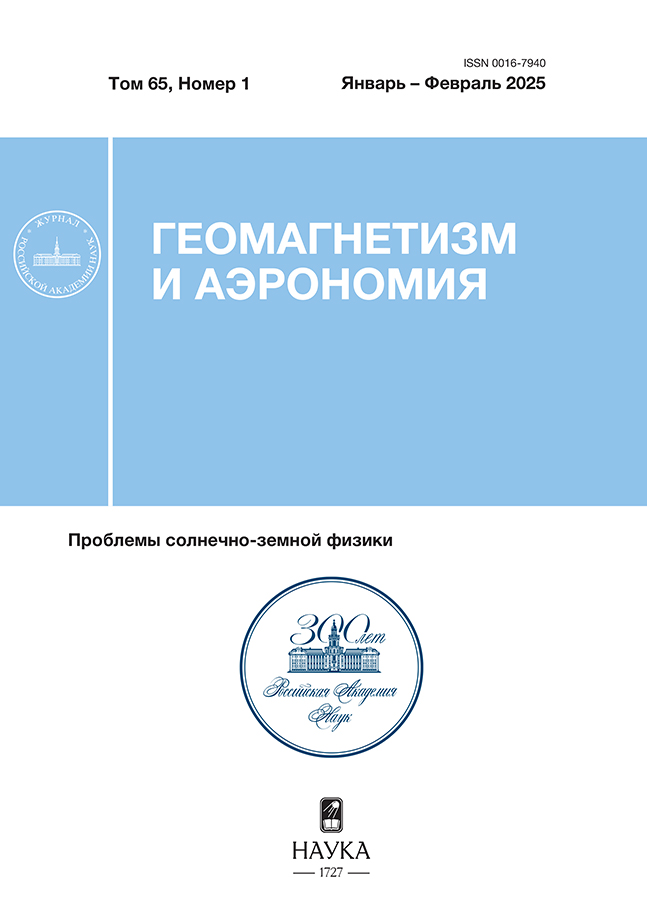Влияние процессов на Солнце и в межпланетной среде на солнечное протонное событие 30.03.2022 г.
- Авторы: Власова Н.А.1, Базилевская Г.А.2, Гинзбург Е.А.3, Дайбог Е.И.1, Калегаев В.В.1,4, Капорцева К.Б.1,4, Логачев Ю.И.1, Мягкова И.Н.1
-
Учреждения:
- Научно-исследовательский институт ядерной физики им. Д.В. Скобельцына Московского государственного университета им. М.В. Ломоносова (НИИЯФ МГУ)
- Физический институт им. П.Н. Лебедева РАН (ФИАН)
- Институт прикладной геофизики им. акад. Е. К. Федорова Росгидромета (ИПГ Росгидромета)
- Московский государственный университет им. М.В. Ломоносова (МГУ)
- Выпуск: Том 65, № 1 (2025)
- Страницы: 25-39
- Раздел: Статьи
- URL: https://rjdentistry.com/0016-7940/article/view/684615
- DOI: https://doi.org/10.31857/S0016794025010031
- EDN: https://elibrary.ru/AENOID
- ID: 684615
Цитировать
Полный текст
Аннотация
Представлены результаты сравнительного анализа солнечного протонного события 30.03.2022 г., имеющего необычный временной профиль потоков солнечных протонов, с предыдущим и последующим солнечными протонными событиями: 28.03.2022 г. и 02.04.2022 г. Возрастания потоков энергичных протонов в межпланетном и в околоземном пространстве ассоциируются с последовательными солнечными вспышками рентгеновских баллов M4.0, X1.3 и M3.9 и тремя корональными выбросами массы типа гало. Работа сделана по экспериментальным данным, полученным с космических аппаратов, расположенных в межпланетном пространстве (ACE, WIND, STEREO A, DSCOVR), на круговой полярной орбите на высоте 850 км (Метеор-М2) и на геостационарной орбите (GOES-16, Электро-Л2). Предложено объяснение особенностей профиля потока энергичных протонов в солнечном протонном событии 30.03.2022 г.: протоны, ускоренные во вспышке 30.03.2022 г., были частично экранированы межпланетным корональным выбросом массы, источником которого стали взрывные процессы на Солнце 28.03.2022 г.; поздняя регистрация максимальных потоков протонов, одновременная для частиц разных энергий, обусловлена приходом потоков частиц внутри межпланетного коронального выброса массы. Пространственное распределение солнечных протонов на околоземной орбите было подобным распределению в точке Лагранжа L1, но с запаздыванием ~50 мин.
Полный текст
Об авторах
Н. А. Власова
Научно-исследовательский институт ядерной физики им. Д.В. Скобельцына Московского государственного университета им. М.В. Ломоносова (НИИЯФ МГУ)
Автор, ответственный за переписку.
Email: nav19iv@gmail.com
Россия, Москва
Г. А. Базилевская
Физический институт им. П.Н. Лебедева РАН (ФИАН)
Email: nav19iv@gmail.com
Россия, Москва
Е. А. Гинзбург
Институт прикладной геофизики им. акад. Е. К. Федорова Росгидромета (ИПГ Росгидромета)
Email: nav19iv@gmail.com
Россия, Москва
Е. И. Дайбог
Научно-исследовательский институт ядерной физики им. Д.В. Скобельцына Московского государственного университета им. М.В. Ломоносова (НИИЯФ МГУ)
Email: nav19iv@gmail.com
Россия, Москва
В. В. Калегаев
Научно-исследовательский институт ядерной физики им. Д.В. Скобельцына Московского государственного университета им. М.В. Ломоносова (НИИЯФ МГУ); Московский государственный университет им. М.В. Ломоносова (МГУ)
Email: nav19iv@gmail.com
Физический факультет
Россия, Москва; МоскваК. Б. Капорцева
Научно-исследовательский институт ядерной физики им. Д.В. Скобельцына Московского государственного университета им. М.В. Ломоносова (НИИЯФ МГУ); Московский государственный университет им. М.В. Ломоносова (МГУ)
Email: nav19iv@gmail.com
Физический факультет
Россия, Москва; МоскваЮ. И. Логачев
Научно-исследовательский институт ядерной физики им. Д.В. Скобельцына Московского государственного университета им. М.В. Ломоносова (НИИЯФ МГУ)
Email: nav19iv@gmail.com
Россия, Москва
И. Н. Мягкова
Научно-исследовательский институт ядерной физики им. Д.В. Скобельцына Московского государственного университета им. М.В. Ломоносова (НИИЯФ МГУ)
Email: nav19iv@gmail.com
Россия, Москва
Список литературы
- Базилевская Г.А., Дайбог Е.И., Логачев Ю.И. Изолированные события солнечных космических лучей, обусловленные приходом быстрых штормовых частиц (ESP) // Геомагнетизм и аэрономия. Т. 63. № 4. С. 503−510. 2023. https://doi.org/10.31857/S0016794023600254
- Дайбог Е.И., Логачев Ю.И., Кейлер С., Кечкемети К. Серии солнечных событий с одинаковыми спадами как инструмент для выделения квазистационарных состояний межпланетного пространства // Космич. исслед. Т. 42. № 4. С. 376–383. 2004.
- Дайбог Е.И., Кечкемети К., Лазутин Л.Л., Логачев Ю.И., Сурова Г.М. 27-дневная периодичность потоков юпитерианских электронов на орбите Земли // Астрон. журн. Т. 94. № 12. С. 1062–1070. 2017. https://doi.org/10.7868/S0004629917120027
- Логачев Ю.И., Базилевская Г.А., Власова Н.А., Гинзбург Е.А., Дайбог Е.И., Ишков В.Н., Лазутин Л.Л., Нгуен М.Д., Сурова Г.М., Яковчук О.С. Каталог солнечных протонных событий 24-го цикла солнечной активности (2009−2019 гг.). Москва: МЦД, 970 с. 2022. https://doi.org/10.2205/ESDB-SAD-008
- Любимов Г.П. Отражательная модель движения СКЛ в петлевых ловушках // Астрон. циркуляр АН СССР. № 1531. С. 19−20. 1988.
- Любимов Г.П., Григоренко Е.Е. Об отражательной модели солнечных космических лучей // Космич. исслед. Т. 45. № 1. С. 12–19. 2007.
- Паркер Е.Н. Динамические процессы в межпланетной среде / Под ред. Л.И. Дормана. М.: МИР, 1965.
- Bazilevskaya G.A. Once again about origin of the solar cosmic rays // Journal of Physics: Conf. Series. V. 798. P. 012034. 2017. https://iopscience.iop.org/article/10.1088/1742-6596/798/1/012034/pdf
- Bryant D.A., Cline T.L., Desai U.D., McDonald F.B. Explorer 12 observations of solar cosmic rays and energetic storm particles after the solar flare of September 28, 1961 // J. Geophys. Res. V. 67. № 13. P. 4983–5000. 1962. https://doi.org/10.1029/JZ067i013p04983
- Burlaga L., Sittler E., Mariani F., Schwenn R. Magnetic Loop Behind an Interplanetary Shock: Voyager, Helios, and IMP 8 Observations // J. Geophys. Res. V. 86. № A8. P. 6673–6684. 1981. https://doi.org/10.1029/JA086iA08p06673
- Burlaga L.F. Magnetic clouds and force-free fields with constant alpha // J. Geophys. Res., Space Physics. V. 93. № A7. P. 7217−7224. 1988. https://doi.org/10.1029/JA093iA07p07217
- Cane H.V., Reames D.V., von Rosenvinge T.T. The role of interplanetary shocks in the longitude distribution of solar energetic particles // J. Geophys. Res. V. 93. № A9. P. 9555−9567. 1988. https://doi.org/10.1029/JA093iA09p09555
- Frassati F., Laurenza M., Bemporad A., West M.J., Mancuso S., Susino R., Alberti T., Romano P. Acceleration of Solar Energetic Particles through CME-driven Shock and Streamer Interaction // Astrophysical Journal. V. 926. № 2. P. 227−246. 2022. https://doi.org/10.3847/1538-4357/ac460e
- Gieseler J., Dresing N., Palmroos C. et al. Solar-MACH: An open-source tool to analyze solar magnetic connection configurations // Front. Astronomy Space Sci. V. 9. 2022. https://www.frontiersin.org/journals/astronomy-and-space-sciences/articles/10.3389/fspas.2022.1058810/full
- Kahler S.W., Sheeley Jr. N.R., Howard R.A., Koomen M.J., Michels D.J., McGuire R.E., von Rosenvinge T.T., Reames D.V. Associations between coronal mass ejections and solar energetic proton events // J. Geophys. Res. V. 89. № A11. P. 9683−9693. 1984. https://doi.org/10.1029/JA089iA11p09683
- Kahler S.W., Reames D.V. Probing the Magnetic Topologies of Magnetic Clouds by Means of Solar Energetic Particles // J. Geophys. Res. V. 96. № A6. P. 9419−9424. 1991. https://doi.org/10.1029/91JA00659
- Kecskeméty K., Daibog E.I., Logachev Y.I., Kóta J. The decay phase of solar energetic particle events // J. Geophys. Res. V. 114. № A6. 2009. https://agupubs.onlinelibrary.wiley.com/doi/pdf/10.1029/2008JA013730
- Klein K.-L., Dalla S. Acceleration and Propagation of Solar Energetic Particles // Space Sci. Rev. V. 212. P. 1107–1136. 2017. https://link.springer.com/article/10.1007/s11214-017-0382-4
- Kocharov L., Kovaltsov G.A., Torsti J., Huttunen-Heikinmaa K. Modeling the solar energetic particle events in closed structures of interplanetary magnetic field // J. Geophys. Res. V. 110. № A12. 2005. https://doi.org/10.1029/2005JA011082
- Lepping R.P., Jones J.A., Burlaga L.F. Magnetic Field Structure of Interplanetary Magnetic Clouds at 1 AU // J. Geophys. Res. V. 95. № A8. P. 11957−11965. 1990. https://doi.org/10.1029/JA095iA08p11957
- Marqué C., Posner A., Klein K.L. Solar energetic particles and radio-silent fast coronal mass ejections // Astrophys. J. V. 642. P. 1222–1235. 2006. https://iopscience.iop.org/article/10.1086/501157
- Masson S., Démoulin P., Dasso S., Klein K.-L. The interplanetary magnetic structure that guides solar relativistic particles // Astron. & Astrophys. V. 538. № A32. 2012. https://doi.org/10.1051/0004-6361/201118145
- Meyer P., Parker E.N., Simson J.A. Solar Cosmic Rays of February, 1956 and Their Propagation through Interplanetary Space // Phys. Rev. V. 104. № 3. P. 768-783. 1956. https://journals.aps.org/pr/pdf/10.1103/PhysRev.104.768?casa_token=_yHvEAClLcEAAAAA%3AN2b4irIb6lbxj2NRvyjazm_9GMXbDKcHv9Y_ecZcJZzI_q0ZDfqSlQOwNxV7QCcsWNn_7OfaXp2VqmgB
- Owens A.J. Interplanetary diffusion of solar cosmic rays—A new approximate analytic solution // J. Geophys. Res. V. 84. № A8. P. 4451 – 4456. 1979. https://doi.org/10.1029/JA084iA08p04451
- Pal S., Dash S., Nandy D. Flux erosion of magnetic clouds by reconnection with the Sun’s open flux // Geophys. Res. Lett. V. 47. № 8. e2019GL086372. 2020. https://doi.org/10.1029/2019GL086372
- Reames D.V. Solar energetic particles: A paradigm shift // Rev. Geophys. V. 33. S1. P. 585−589. 1995. https://doi.org/10.1029/95RG00188
- Reames D.V. The two sources of solar energetic particles // Space Science Reviews. V. 175. P. 53–92. 2013. https://doi.org/10.1007/s11214-013-9958-9
- Reames D.V. Solar Energetic Particles. A Modern Primer on Understanding Sources, Acceleration and Propagation / Part of the book series: Lecture Notes in Physics (LNP, volume 932) 2017.
- Reames D.V. How Do Shock Waves Define the Space-Time Structure of Gradual Solar Energetic Particle Events? // Space Science Reviews. V. 219. A14. 2023. https://doi.org/10.1007/s11214-023-00959-x
- Reinard A.A., Biesecker D.A. Coronal mass ejection associated coronal dimmings // Astrophys. J. V. 674. P. 576−585. 2008. https://iopscience.iop.org/article/10.1086/525269
- Richardson I.G. Energetic particles and corotating interaction regions in the solar wind // Space Science Reviews. V. 111. P. 267–376. 2004. https://doi.org/10.1023/B:SPAC.0000032689.52830.3e
- Richardson I.G. Solar wind stream interaction regions throughout the heliosphere // Living Reviews in Solar Phys. V. 15. A1. 2018. https://doi.org/10.1007/s41116-017-0011-z
- Shen C., Wang Y., Ye P., Wang S. Enhancement of Solar Energetic Particles During a Shock – Magnetic Cloud Interacting Complex Structure // Solar Phys. V. 252. P. 409–418. 2008. https://link.springer.com/article/10.1007/s11207-008-9268-7
- Tan L.C., Malandraki O.E., Reames D.V., Ng C.K., Wang L., Dorrian G. Use of incident and reflected solar particle beams to trace the topology of magnetic clouds // Astrophys. J. V. 750. № 2. P. 146−167. 2012. https://iopscience.iop.org/article/10.1088/0004-637X/750/2/146/meta
- Torsti J., Riihonen E., Kocharov L. The 1998 May 2–3 magnetic cloud: an interplanetary “highway” for solar energetic particles observed with SOHO/ERNE // Astrophys. J. V. 600. P. L83–L86. 2004. https://iopscience.iop.org/article/10.1086/381575
- Vlasova N.A., Bazilevskaya G.A., Ginzburg E.A., Daibog E.I., Kalegaev V.V., Kaportseva K.B., Logachev Yu.I., Myagkova I.N. Solar Energetic Proton Fluxes in Near-Earth Space on March 13–23, 2023 // Cosmic Res. V. 62. № 2. C. 197−209. 2024. https://link.springer.com/article/10.1134/S0010952523600282
- Vörös Z., Varsani A., Yordanova E., Sasunov Y.L., Roberts O.W., Kis Á., Nakamura R., Narita Y. Magnetic reconnection within the boundary layer of a magnetic cloud in the solar wind // Journal of Geophysical Research: Space Physics. V. 126. № 9. e2021JA029415. 2021. https://doi.org/10.1029/2021JA029415
- Wu S.-S., Qin G. Magnetic Cloud and Sheath in the Ground-level Enhancement Event of 2000 July 14. I. Effects on the Solar Energetic Particles // Astrophys. J. V. 904. № 2. P. 151−159. 2020. https://doi.org/10.3847/1538-4357/abc0f2
- Zhang M., Cheng L., Zhang J., Riley P., Kwon R.Y., Lario D., Balmaceda L., Pogorelov N.V. A Data-driven, Physics-based Transport Model of Solar Energetic Particles Accelerated by Coronal Mass Ejection Shocks Propagating through the Solar Coronal and Heliospheric Magnetic Fields // Astrophys. J.: Supplement Series. V. 266. № 2. P. 35−54. 2023. https://doi.org/10.3847/1538-4365/accb8e
Дополнительные файлы

















